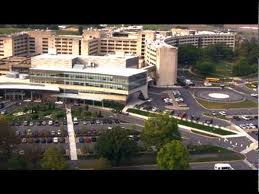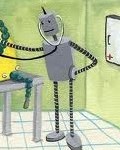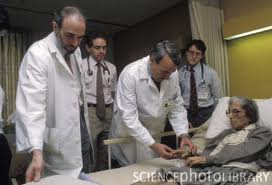- Two Thanksgiving Thoughts for the ACAPosted 10 years ago
- Shop til you Drop at the Healthcare Marketplace Part 2: Frustration!Posted 10 years ago
- An Early Casualty in the Affordable Care FightPosted 10 years ago
- Some Good News for a ChangePosted 10 years ago
Medical School and Health Care Reform
I have been working with a group of my fellow Medical School alumni on an upcoming event. I returned to the campus recently to find it far bigger, modernized and more complex than ever. It came as no surprise. It mirrors what is happening in medical education in general.
 I also have a young friend who has just started medical school at my alma mater so it has been interesting to compare notes as he wades into what will be a long period of training and indoctrination. The layout of the curriculum has changed little, though the method of getting through it looks more user-friendly. Computers and evidence-based medicine have had a transformative and positive effect, but much of the substance remains the same.
I also have a young friend who has just started medical school at my alma mater so it has been interesting to compare notes as he wades into what will be a long period of training and indoctrination. The layout of the curriculum has changed little, though the method of getting through it looks more user-friendly. Computers and evidence-based medicine have had a transformative and positive effect, but much of the substance remains the same.
The first two years of training lay the foundation of medical sciences. There is anatomy and physiology, how the body is constructed and how it functions. Students learn disease at the gross level down to the sub-microscopic level. The biochemistry of bodily function at the organic and cellular level is explored, so you can later understand how pharmacology will have its effect. Patient sightings were once scarce.
In my time, there was growing criticism that medical education had become so scientific it was dehumanizing, turning doctors into body mechanics.  Psychology and human behavior have since been injected into the curriculum. So has more community medicine and public health. One newer and important addition is medical economics. I was taught to do what was scientifically correct and not worry about the costs. Costs are a huge problem these days.
Psychology and human behavior have since been injected into the curriculum. So has more community medicine and public health. One newer and important addition is medical economics. I was taught to do what was scientifically correct and not worry about the costs. Costs are a huge problem these days.
The second two years you get to learn from patients at the bedside. You spend time in almost every medical specialty, though some inevitably feel like a speedy pass-through. All along you are getting tested and retested to see what you have learned and retained. Four years later you are handed a diploma, somewhat to your surprise, because you feel no more ready to treat sick patients than you do to fix a Rolls Royce.
 You enter residency (the first year still called internship some places, PGY-1 status most others) and from there you go on specializing and sub-specializing and perhaps sub-sub-specializing until finally you are educated. I learned that a career in medicine is called a practice because you need to keep working at it to get it right. Just when you get some mastery, a new finding, a new technique, even a new disease like AIDS comes along and you are back at it again.
You enter residency (the first year still called internship some places, PGY-1 status most others) and from there you go on specializing and sub-specializing and perhaps sub-sub-specializing until finally you are educated. I learned that a career in medicine is called a practice because you need to keep working at it to get it right. Just when you get some mastery, a new finding, a new technique, even a new disease like AIDS comes along and you are back at it again.
If you so choose, you can remain in training for over ten years, counting medical school. This is after a pre-medical course of study in undergraduate college that is isolating. Those who stay in training, and out of the job market, can enter at much higher income levels than family medical doctors, general pediatricians, general internists and general surgeons. No wonder there is fierce competition for specialty training positions. Eventually the doctor does emerge from what may feel like a giant cocoon. Some doctors choose to stay in research, other choose academic careers which combine medical practice, teaching and research as a mix. Most begin clinical practice.
 Some of medical education is wasted. I recall sitting in a long lecture about what the raccoon’s paw tells the raccoon’s brain. I never treated a raccoon after that. Never thought I would. The lecturers that day had spent their lives in raccoon research and were on the basic science staff. I recall another lecture about bowling teams in a community. It turned up on the test. Never treated any bowling teams either. But given the vast amount of medical intelligence out there most of the education had some relevance. Relevance however is like shooting fish in a barrel given the data available.
Some of medical education is wasted. I recall sitting in a long lecture about what the raccoon’s paw tells the raccoon’s brain. I never treated a raccoon after that. Never thought I would. The lecturers that day had spent their lives in raccoon research and were on the basic science staff. I recall another lecture about bowling teams in a community. It turned up on the test. Never treated any bowling teams either. But given the vast amount of medical intelligence out there most of the education had some relevance. Relevance however is like shooting fish in a barrel given the data available.
There were parts of training that approached college initiation — hazing. A certain amount of “I had to suffer so you will also suffer” thinking went into clinical training. Luckily laws now restrict some of the most outrageous aspects of that. It should noted that people get sick 24/7 and no reasonable doctor enters training thinking he is going to have the same hours as the local bank president. That said, no patient should be in a critical situation with a house officer who is seriously sleep-deprived to protect an attending (and billing) doctor home watching football.
 What is still missing from medical education is any national planning or on-going rethinking with any teeth in it. No one says how many ophthalmologists we need in this country. It is left to medical schools and training hospitals to determine the number produced. Many specialty organizations, who also certify trainees, have been very good at making sure not so many specialists are produced that they drive down the income of existing practitioners. Turf protection should not be the overriding concern here.
What is still missing from medical education is any national planning or on-going rethinking with any teeth in it. No one says how many ophthalmologists we need in this country. It is left to medical schools and training hospitals to determine the number produced. Many specialty organizations, who also certify trainees, have been very good at making sure not so many specialists are produced that they drive down the income of existing practitioners. Turf protection should not be the overriding concern here.
Nor do we know how many medical schools we need, where and how many training programs we need in any specialty, how many nurses or skilled technicians. OK, so everyone is running around talking about the shortage of primary care doctors now and in the future. What do we do about it? Not run around and talk. Not too long ago newly trained pediatricians were having trouble finding jobs. Insurance companies were cutting payments for well-child exams and the demand plummeted. Someone centrally ought to be monitoring that, and planning accordingly. Medical training is expensive! Many doctors emerge with six-figure debt. Most medical schools rely on state or donor support.
 There will be those who will scream “government interference” and “medical socialism” at the thought of centralized planning in the US. Why should one area of the country have one cardiologist per population and another 10. Why should Massachusetts have twice as many doctors as Texas? In this day of rising costs and stagnant paychecks, it makes sense to try to maximize our resources and plan for an intelligent disbursement of these costly assets in the future. If government tries this, you can expect shrieking from laissez-faire free-marketers protecting their turf. In the past century the free market has given us the health care crisis we have now — high costs, under-served geography, under-served populations, over-treated patients who pay and untreated patients who can’t. Reform is needed. Education must figure into that. How can we reasonably expect a different result doing exactly the same thing all over again?
There will be those who will scream “government interference” and “medical socialism” at the thought of centralized planning in the US. Why should one area of the country have one cardiologist per population and another 10. Why should Massachusetts have twice as many doctors as Texas? In this day of rising costs and stagnant paychecks, it makes sense to try to maximize our resources and plan for an intelligent disbursement of these costly assets in the future. If government tries this, you can expect shrieking from laissez-faire free-marketers protecting their turf. In the past century the free market has given us the health care crisis we have now — high costs, under-served geography, under-served populations, over-treated patients who pay and untreated patients who can’t. Reform is needed. Education must figure into that. How can we reasonably expect a different result doing exactly the same thing all over again?
Tom Godfrey








Insanity: doing the same thing over and over again and expecting different results
Medicine in US is simply an extension of the Social Darwinian approach, with a touch of angst, we seem to be taking toward every aspect of our lives. It is frustrating. All the points you made are very valid and can in spirit be transfered to many social ailments we face today. Medicine has come a long way over the last few hundred years. The scope with which we practice has completely changed. We no longer treat a single ailment, we need to treat the person and we need to treat the community. The failure to see this will result in the demise of the most privileged of individuals. Man is NOT an island. The parallels are uncany. You can practice libertarian philosophy when you live in the woods by yourself. The social equation has changed. I was hoping Obama would have brought about the change needed.
So, did I. I was glad to see him raise the specter of Social Darwinism earlier this week. My fear is that to many Americans that term will not have meaning, and to others it may suggest Social Darwinism is acting like monkey. How many will look it up?
I think sometimes we are living in the Silver-plated era as opposed to the Gilded age of the 1870’s and 80’s. Corruption in government was rampant then. Disparity between the rich and poor was great. Moguls controlled the Conservative movement. Labor conditions were terrible. The spoils system in Washington was rampant. Things are not so bad as then for the average American, so I term it silver. We do not see the kinds of homes being built in say New Port Rhode Island or Park Avenue New York as we did back then. Romney’s house with the car elevator means something comparable is going up, though.
It is only the pressure from an informed and vigilant public that will keep the train of Progress on the track. It is an exhausting task. The foolish and self-serving are everywhere. Yet it must be done by us. TG
Absorbing all this for a while… I realize that this may all define the American Way. Perhaps we need to ask that question. What do we all feel is the American way? Using the social contract as a stepping stone to riches? The Gold rush? Land of opportunity… at any cost? Do we put forth our inalienable rights above others? The “rich” should not be required to “keep” the poor. (It is actually in their best interest). Curiously, the avid defenders of the Capitalistic system is not so much the top 1%, but those afforded the comforts of common decent living by the “socialist” ways. Are they holding onto that dream… the pot of gold at the end of the rainbow? Are they holding onto their inalienable rights? As per John Locke… who wrote them to benefit the colonist over the Indians. Who are we and what is it we want? We may all be battling demons – Conservatives with Wellfare addicts and Liberals with Barons.